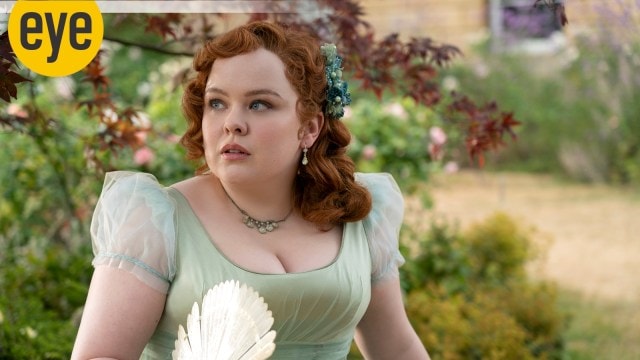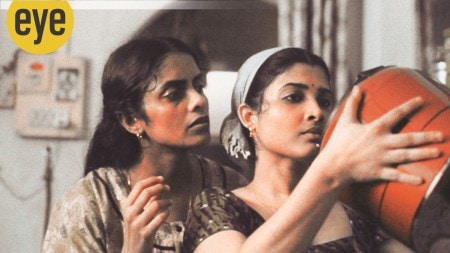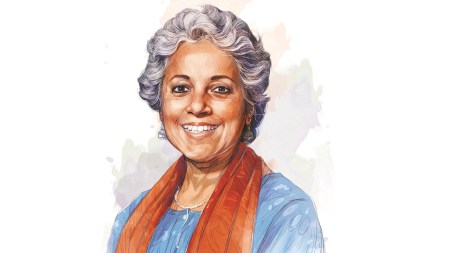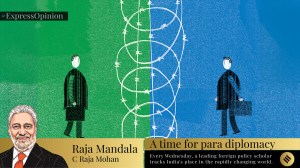- India
- International
Bridgerton 3 and Penelope as its onlooker-outsider protagonist: When the wallflower blooms
As a new season of the globally-acclaimed Regency-era romance Bridgerton arrives next week and the spotlight shifts to its onlooker-outsider protagonist, a look at the perks of being a wallflower.
 Nicola Coughlan as Penelope Featherington in Bridgerton. (Photo: Liam Daniel/Netflix © 2024)
Nicola Coughlan as Penelope Featherington in Bridgerton. (Photo: Liam Daniel/Netflix © 2024)Wallflower: a pleasant smelling garden plant that has yellow, orange, or brown flowers that grow in groups; a shy person, especially a girl or woman, who is frightened to involve herself in social activities and does not attract much interest or attention.
The traits that stand out from the Cambridge Dictionary meaning offer a clue to the personality of a wallflower, botanical or human: “Pleasant”, “shy”, but also sturdy, thriving in environments that require little care or nourishment, a peripheral presence capable of blossoming under care.
It’s difficult to imagine a person with such attributes as the “diamond of the season” — the “incomparable” debutante who takes centre stage in each volume — and now, thanks to its successful OTT adaptation – in each season of the Regency romance, Bridgerton. The royal court is where the search for suitable partners for the society’s elite begins. In this setting, as in every other social gathering, the wallflower’s place is in the background, lost in the melee, the outsider who can’t seem to break in.
The wallflower as a literary trope peaked with Stephen Chbosky’s charming coming-of-age novel, The Perks of Being a Wallflower (2012). Through the story of Charlie, an introverted teenager learning to negotiate friendship, love and sexuality, Chbosky speaks for all the unobtrusive wallflowers who understand the language of silence and whose awareness of their surroundings gives them a quiet empathy. “You see things. You keep quiet about them. And you understand,” writes Charlie in the epistolary YA novel. Charlie is a person of thought, not action. His attempts to adapt to his world, and to eventually understand it, are limited to this self-introspective awareness rather than to pragmatic experiences and interventions.
Contrary to Charlie, Penelope Featherington, the lead in Julia Quinn’s Romancing Mr Bridgerton (2002) — the focus of the third season, the first part of which premieres on Netflix on May 16 — is not a woman given merely to passive observations. For long, she has been the quiet onlooker, overlooked for other, more vibrant contemporaries because nothing about her screamed conformity. Like Charlie, she sees things, she understands, but she doesn’t keep quiet. She writes about them, anonymously.

The setting of Quinn’s novel is the early-19th century Regency era, when Queen Consort Charlotte held sway. Penelope’s appearance — from her weight to the unflattering colour palette thrust upon her, to her social awkwardness — are a departure from the norm. She is the youngest of three siblings with an overbearing mother who undermines her constantly. At dances and balls, the accepted courting ritual of the era, potential suitors rarely gravitate towards her. “She tried to remind herself that beauty was only skin deep, but that didn’t offer any helpful excuses when she was berating herself for never knowing what to say to people. There was nothing more depressing than an ugly girl with no personality,” Penelope thinks to herself in the novel. Marriage, before Colin Bridgerton discovers the person behind the persona, seems almost an impossibility even though “Deep inside, she knew who she was, and that person was smart and kind and often even funny, but somehow her personality always got lost somewhere between her heart and her mouth, and she found herself saying the wrong thing or, more often, nothing at all.”
Always on the periphery of society, Penelope’s position, however, lends itself automatically to her becoming the keeper of secrets, the invisible witness to the laughter, tears and machinations of the social set. But, unlike Charlie, she turns her observations into agency, honing her considerable wit and intelligence to show up a mirror to the Ton. Her loneliness amuses itself by choosing to be contrarian. The thrill of writing and producing Lady Whistledown’s Society Papers, whose provenance and range of gossip remain a matter of curiosity and deep interest to the Ton, is a subversion that few of her elite contemporaries could imagine. As Lady Whistledown, Penelope comes into her own. She is no longer at a loss for words — her insights into the pretentiousness of her contemporaries come cloaked in sardonic humour. There’s a power reversal in the way Penelope wrests back control through her secret life.
 (L to R) James Phoon as Harry Dankworth, Bessie Carter as Prudence Featherington, Harriet Cains as Philipa Featherington, Lorn Macdonald as Albion Finch, Nicola Coughlan as Penelope Featherington in Bridgerton. (Photo: Liam Daniel/Netflix © 2024)
(L to R) James Phoon as Harry Dankworth, Bessie Carter as Prudence Featherington, Harriet Cains as Philipa Featherington, Lorn Macdonald as Albion Finch, Nicola Coughlan as Penelope Featherington in Bridgerton. (Photo: Liam Daniel/Netflix © 2024)
****
Unlike Chbosky’s much more contemporary setting, Quinn’s Bridgerton universe is a throwback to a different era altogether. But in her telling, and more so, in the Netflix adaptation, this is a world very different from the real thing. The globally-acclaimed show is set in an alternative universe that is colour-blind, where an ebony-skinned Queen rules over subjects of various ethnicities. It is also a world, where despite the restrictive social mores — women could not inherit property, for instance, or travel unchaperoned, or, for that matter, even hold a job for the love of it — the women are spirited and unconventional in their assertions of independence. From Lady Bridgerton, the family matriarch, to the feisty Kate Sharma who marries the eldest Bridgerton brother Anthony, from Eloise, the fifth Bridgerton sibling and her pursuit of the intellectual life to Penelope with her razor-sharp wit and sharper quill, women are unafraid to claim space for themselves and raise uncomfortable questions.
By definition, a wallflower is a survivor, tenacious and self-sustaining even when conditions are adverse. Penelope Featherington shows what sets it apart from other, better-tended variants — insouciance.
May 22: Latest News
- 01
- 02
- 03
- 04
- 05





































